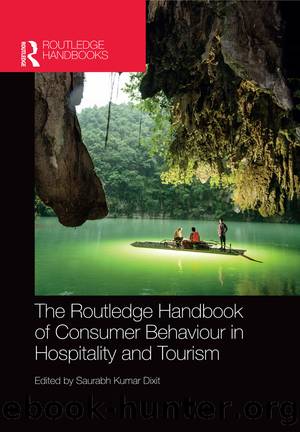The Routledge Handbook of Consumer Behaviour in Hospitality and Tourism by Dixit Saurabh Kumar;

Author:Dixit, Saurabh Kumar;
Language: eng
Format: epub
Publisher: Taylor & Francis Group
23
Customer Complaint Behaviour
Poh Theng, Loo
Customer complaint behaviour (CCB) and its importance
There are many studies that have defined customer complaint behaviour (CCB) over the past few decades (Sharma et al. 2010). The earliest definition of CCB was introduced by Jacoby and Jaccard (1981), as being the action taken by an individual to communicate negative comments about a product or service towards a company or a third-party organizational entity. Later, Singh (1988) proposed CCB as behavioural (public or private action) and non-behavioural responses (no action) triggered by perceived dissatisfaction with a purchase and consumption experience. The dissatisfaction was caused by the negative disconfirmation of purchase expectations that led to complaint behaviour (Keng et al. 1995). Overall, CCB can be defined as behavioural and non-behavioural actions taken by a dissatisfied customer for his or her below-expected purchase or consumption experience.
Understanding CCB is critical for the services industry, including the hospitality and tourism industry. This is especially so as Goodman (1999) reveals that it is five times more expensive to win a new customer than to keep a current customer. Understanding CCB can enable industry practitioners to be aware of their areas for improvement, such as effective complaint remedies and service recovery to restore customer satisfaction and customer loyalty; these are, undoubtedly, imperative. Previous studies have proved that customer satisfaction in complaint remedies affects customer re-patronage intentions (Conlon and Murray 1996; Davidow 2000; Susskind 2005). Furthermore, a better understanding of CCB can help hospitality and tourism organizations to be proactive in handling complaints (Wildes and Seo 2001). Services organizations should view understanding CCB as an opportunity to strengthen relationships with customers (Blodgett et al. 1995; Kim and Boo 2011) and to learn about problems in order to provide better-quality products and services (Ngai et al. 2007). By doing so, services organizations in hospitality and tourism can develop effective customer complaint management systems for maximization of customer satisfaction, customer loyalty and, ultimately, profits. The importance of understanding CCB is further supported by a study of Blodgett et al. (1995) which revealed that 77% of all customers who had a bad experience did not complain but they engaged in negative word-of-mouth (WOM). However, only 48% of the complaining customers engaged in negative WOM before seeking redress. According to past statistics, on average, 50% of the customers tend to complain about a problem to a front-line employee but only 1–5% of customers will launch their complaints to a manager or headquarters (Goodman 1999). These statistics show the importance of understanding CCB by the organizations and service employees so that they are able to respond and handle customer complaints effectively.
Table 23.1 Types of CCB responses
Hirschman (1970) Exit is an active and destructive response to dissatisfaction which is related to the break of relationship with the service provider.
Voice is a verbal and constructive response with an expectation of change in the organization’s practices, policies and responses which is usually addressed with friends and other organizations.
Loyalty has two aspects which are constructive and passive, whereby customers hope that things will
Download
This site does not store any files on its server. We only index and link to content provided by other sites. Please contact the content providers to delete copyright contents if any and email us, we'll remove relevant links or contents immediately.
Life 3.0: Being Human in the Age of Artificial Intelligence by Tegmark Max(5152)
The Sports Rules Book by Human Kinetics(4048)
The Age of Surveillance Capitalism by Shoshana Zuboff(3959)
ACT Math For Dummies by Zegarelli Mark(3834)
Blood, Sweat, and Pixels by Jason Schreier(3468)
Unlabel: Selling You Without Selling Out by Marc Ecko(3451)
Hidden Persuasion: 33 psychological influence techniques in advertising by Marc Andrews & Matthijs van Leeuwen & Rick van Baaren(3270)
Urban Outlaw by Magnus Walker(3222)
The Pixar Touch by David A. Price(3183)
Bad Pharma by Ben Goldacre(3067)
Project Animal Farm: An Accidental Journey into the Secret World of Farming and the Truth About Our Food by Sonia Faruqi(2988)
Brotopia by Emily Chang(2872)
Slugfest by Reed Tucker(2772)
Kitchen confidential by Anthony Bourdain(2772)
The Content Trap by Bharat Anand(2756)
The Airbnb Story by Leigh Gallagher(2665)
Coffee for One by KJ Fallon(2398)
Smuggler's Cove: Exotic Cocktails, Rum, and the Cult of Tiki by Martin Cate & Rebecca Cate(2324)
Beer is proof God loves us by Charles W. Bamforth(2236)
